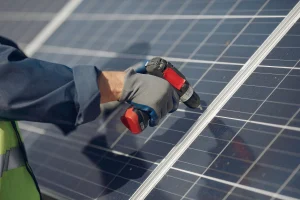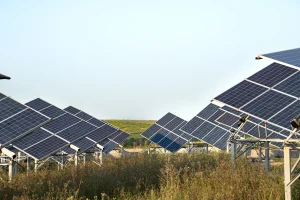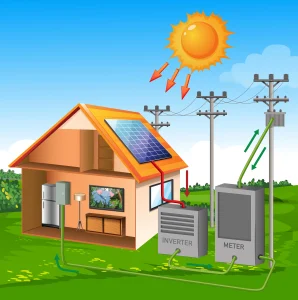The static inverter is one of the most important components of our existing electrical systems these days, especially in renewable energy-based solar and wind power systems. The direct current (DC) generated by these systems must be inverted to alternating current (AC) so it can be used by the grid or your household appliances.
Core Principles of Static Inverters
The Role of Power Conversion in Static Inverters
First of all, it is important to mention the static inverters, which are essential in the conversion of electrical energy, mainly from DC to AC. This step is very crucial in modern energy systems where DC power generation is widely used in the context of residential, commercial and industrial applications while electricity is needed in AC form.
Static inverters facilitate such conversion to ensure that energy sources like batteries, solar panels, etc., are compatible with the device they power. The performance and consistency aggregates to be a significant foundation for the firm and even all the various operations within counterpart networks.
Key Components and Their Functions in Static Inverters
The core components of a static inverter include the rectifier, inverter bridge, control circuits, and filters. Each part has a specific function:
Rectifier: Converts AC input into DC output when reverse conversion is required.
Inverter Bridge: Transforms DC into AC using semiconductor switches such as IGBTs or MOSFETs.
Control Circuits: Regulate voltage levels, manage frequency stability, and oversee the overall operation.
Filters: Remove noise and harmonics to ensure clean output power.
These components work together seamlessly to deliver high-quality AC power suitable for sensitive equipment.
The Operation Mechanism of a Static Inverter
AC to DC Conversion Process
Static inverters first convert their incoming AC input to DC with a rectifier. The process smoothens the electrical current coming in by removing the mismatches found in AC. This is accomplished in rectifiers by allowing current to only circulate one-way using diodes or controlled switches.
DC to AC Conversion and Waveform Control
This energy is then entered into an inverter bridge where it is converted back to AC after conversion to DC. You find this output waveform to be pure sine waves, which are identical to grid power sine waves, and that is the challenge.
Unlike basic static inverters which only produce those traditional square waves, advanced static inverters use pulse-width modulation (PWM) methods to create finely shaped waveforms that are safe for connected sensitive electronics.
Voltage Regulation and Frequency Stabilization
It provides voltage regulation by keeping the output in the prescribed range, despite changes in load or input conditions. Keep an unchanged frequency needed to achieve synchronization with the grid system or other devices connected to the grid. The frequency stabilization keeps a stable frequency of 50Hz or 60Hz which is also very important for sync with grid systems or other connected systems.
Applications of Static Inverters in Electrical Systems
Industrial Applications for Power Backup Solutions
Static inverters are an important part of industrial setups where uninterrupted power supplies (UPS) are required. They ensure backup during power interruptions and spare critical equipment from unproductive time or machine destruction. To illustrate, industries are dependent on solutions like the REVO VM II PRO which has a high solar charging current and supports functions without a battery.
Integration with Renewable Energy Systems
A static inverter has a crucial role to play in coupling solar panels or wind turbines to the existing grids with renewable energy being their only foothold. Rather, machines with photovoltaic storage convert excess electricity into reusable energy by storing it, which helps to make the energy consumption process effective.
Enhancing Efficiency in Data Centers and IT Infrastructure
Data centers require stable backup power supplies that are continuously running the server and other IT infrastructure. Static inverters offer not only regularized voltage levels but also lesser energy losses, thus making them an indispensable component of modern-day data centre management facilities.
Advantages of Using SOROTEC Static Inverters
High Efficiency and Energy Savings Features
One of the key benefits of using static inverters is their efficiency, making sure that as little energy as possible is lost during the conversion process. They transform the DC to AC with high power conversion efficiency and low loss. Such efficiency is extremely important in applications like renewable energy systems, where the benefit is the full exploitation of produced power.
Static inverters implement new technology, like pulse-width modulation, which produces better energy performance, making them a practical foundation for sustainable energy. Most models also feature smart load management capabilities that enable users to prioritize energy allocation depending on demand.
Advanced Control Systems for Stable Performance
With the help of advanced control systems, static inverters are under control and thus can provide stable and reliable performance despite variable conditions. These control circuits continue to regulate voltage and control frequency stability, which is especially important in sensitive equipment that requires consistent power quality.
Other capabilities such as the online software upgrade and remote monitoring provide operational flexibility allowing real-time adjustments for optimally balanced and dry-run operations.
There are also ground-breaking features available in some models like mains delay and options for a current transformer (CT) so the reverse current is blocked. Such features contribute to the protection of connected devices as well as prolonging the life of a system by reducing wear and tear on parts.
Recommendations for Selecting the Right SOROTEC Static Inverter
Key Factors to Consider Based on Application Requirements
When selecting a static inverter from SOROTEC, understanding your specific application requirements is vital. Key factors include:
Power Capacity: Ensure the inverter’s capacity matches your energy demands. For industrial applications or large-scale setups, high-capacity models are preferable.
Battery Compatibility: If integrating with an energy storage system, choose an inverter that supports lithium battery communication via RS485 or CAN ports.
Scalability: For expanding operations, opt for models supporting parallel connections or three-phase outputs.
Environmental Conditions: Evaluate protection grades like IP65 for outdoor installations or areas prone to dust and moisture.
Suggested SOROTEC Models for Specific Use Cases
Different applications demand tailored solutions to ensure optimal performance:
REVO VM IV features RGB touch screens while its dual-output intelligent load management functionality makes it ideal for residential use. Higher capacity models such as REVO HMT offer single and three-phase output combined with higher photovoltaic input currents for commercial and industrial applications.
For renewable energy integration, the REVO HM series specializes in handling solar panel inputs and can support up to six devices in parallel. State-of-the-art voltage regulation and frequency stabilization ensure a non-interrupted power supply, which is essential to the IT infrastructure in data centers.
By aligning model features with application needs, you can achieve efficient energy utilization while ensuring system reliability.
FAQs
Q1. Why are static inverters so efficient relative to other converters?
A: Static inverters incorporate modern techniques such as pulse-width modulation (PWM), which allow for high fidelity and low loss wave shaping of power from DC to AC conversion.
Q2. How do advanced control systems enhance the reliability of static inverters?
A: Control systems are used to help maintain voltage levels and stabilize frequency as load changes from one point in the grid to another or as load patterns go up and down over time.
Q3. What to consider while selecting a static inverter?
A: You should consider the power capacity, battery compatibility, the feasibility of connecting several modules in parallel, the scalability, and also the environmental protection grades according to the application requirements.










